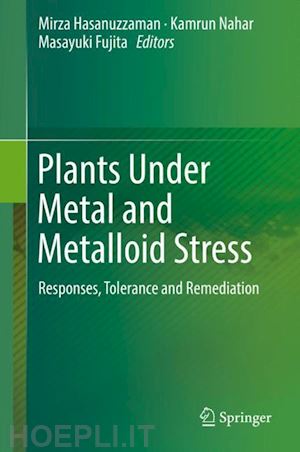
Questo prodotto usufruisce delle SPEDIZIONI GRATIS
selezionando l'opzione Corriere Veloce in fase di ordine.
Pagabile anche con Carta della cultura giovani e del merito, 18App Bonus Cultura e Carta del Docente
In the industrial era, the most important potential threat to crop production is abiotic stress, including toxic metal/metalloid stress. Growing populations and rapid industrialization lead to the generation and release of huge amounts of toxic metals/metalloids into the environment, altering plant physiological processes and reducing yields. In the last few decades, there has been extensive research to elucidate the mechanisms of tolerance to metal/metalloid toxicity and ways to improve the defense system in plants. Use of exogenous photoprotectants such as osmoprotectants, plant nutrients, phytohormones, signaling molecules, antioxidants, amino acids and organic acids are widely being used to improve plants’ tolerance to metal/metalloid stress. Recently, phytoremediation approaches have been effectively employed to remediate metal/metalloid pollution. This book presents the latest insights intoplant responses and tolerance in plants grown under metal/metalloids stress to provide a better understanding of the topic and the future outlook.
Chapter 1: Recent Advances in Metal Induced Stress Tolerance in Plants: Possibilities and Challenges.- Chapter 2: Physiological, Biochemical Changes, and Phytotoxicity Remediation in Agricultural Plant Species Cultivated in Soils Contaminated with Copper and Zinc.- Chapter 3: Heavy Metal Toxicity and Antioxidative Response In Plants: An Overview.- Chapter 4: Mechanism of reactive oxygen species (ROS) production in plants exposed to metal/metalloids.- Chapter 5: Antioxidant Defense System in Plants Exposed to Metal Toxicity.- Chapter 6: Stress Signaling under metal and Metalloid Toxicity.- Chapter 7: Metal Accumulation in Estuarine Plants: Investigating the Effect on the Levels of Non-Protein Thiols in Roots of Different Salt Marsh Plants.- Chapter 8: Role of Compatible Solutes in Enhancing Antioxidative Defense in Plants Exposed to Metal Toxicity.- Chapter 9: Role of Polyamines in Mediating Antioxidant Defense and Epigenetic Regulation in Plants Exposed to Heavy Metal Toxicity.- Chapter 10: Phytoremediation of Metal And Metalloids From Contaminated Soil.- Chapter 11: Heavy Metal Hyperaccumulation and Hypertolerance in Brassicaceae.- Chapter 12: Phytoremediation in Waste Management: Hyper accumulation Diversity and Techniques.- Chapter 13: Role of Micro-Organisms in Modulating Antioxidant Defence in Plants Exposed to Metal Toxicity.- Chapter 14: Symbiotic Microorganisms Enhance Antioxidant Defense in Plants Exposed to Metal/Metalloid-Contaminated Soils.- Chapter 15: Cadmium Hyperaccumulation by Brassica species application in Remediation.- Chapter 16: Mitigating cadmium toxicity in plants by phytohormones.- Chapter 17: Use of fungi in mitigating cadmium toxicity in plants.- Chapter 18: Molecular Approaches in Enhancing Metal/Metalloid-induced Oxidative Stress Tolerance.- Chapter 19: Future Tools for The Development of Metal/Metalloid-induced Oxidative Stress Tolerance.
Mirza Hasanuzzaman is a Professor of Agronomy at Sher-e-Bangla Agricultural University, Dhaka, Bangladesh. In 2012, he received his PhD with a dissertation on ‘Plant Stress Physiology and Antioxidant Metabolism’ from the United Graduate School of Agricultural Sciences, Ehime University, Japan with a Japanese Government (MEXT) Scholarship. Later, he completed his postdoctoral research in the Center of Molecular Biosciences (COMB), University of the Ryukyus, Okinawa, Japan with a ‘Japan Society for the Promotion of Science (JSPS)’ postdoctoral fellowship. Subsequently, he became an Adjunct Senior Researcher at the University of Tasmania with an Australian Government’s Endeavour Research Fellowship. Prof. Hasanuzzaman has published over 70 articles in peer-reviewed journals and books, and has edited 3 books and written 35 book chapters on important aspects of plant physiology, plant stress responses, and environmental problems in relation to plant species.He is Editor and a reviewer for more than 50 peer-reviewed international journals and the recipient of ‘Publons Peer Review Award 2017’. He is an active member of 40 professional societies and is the Publication Secretary of the Bangladesh Society of Agronomy. He received the World Academy of Science (TWAS) Young Scientist Award 2014.
Kamrun Nahar is an Associate Professor at the Department of Agricultural Botany at Sher-e-Bangla Agricultural University, Dhaka, Bangladesh. She obtained her B.Sc.Ag. (Hons.) and M.S. in Agricultural Botany from the same university. She received her second M.S. degree in 2013 from Kagawa University, Japan and her PhD Degree with a thesis on ‘Environmental Stress Physiology of Plants’ in 2016 from the United Graduate School of Agricultural Sciences, Ehime University, Japan with a Japanese Government (MEXT) Scholarship. She has published 50 articles and chapters related to plant physiology and environmental stresses. She isinvolved in editorial activities and is a reviewer for international journals. She is an active member of 20 professional societies.
Masayuki Fujita is a Professor at the Laboratory of Plant Stress Responses, Faculty of Agriculture, Kagawa University, Kagawa, Japan. He received his B.Sc. in Chemistry from Shizuoka University, Shizuoka, and M.Agr. and Ph.D. in Plant Biochemistry from Nagoya University, Nagoya, Japan. His research interests include physiological, biochemical, and molecular biological responses based on secondary metabolism in plants under various abiotic and biotic stresses. In the last decade his work focused on oxidative stress and antioxidant defense in plants under environmental stress. His group is investigating the role of different exogenous protectants in enhancing antioxidant defense and methylglyoxal detoxification systems in plants. He has written 150 publications in journal and books and has edited 4 books.











Il sito utilizza cookie ed altri strumenti di tracciamento che raccolgono informazioni dal dispositivo dell’utente. Oltre ai cookie tecnici ed analitici aggregati, strettamente necessari per il funzionamento di questo sito web, previo consenso dell’utente possono essere installati cookie di profilazione e marketing e cookie dei social media. Cliccando su “Accetto tutti i cookie” saranno attivate tutte le categorie di cookie. Per accettare solo deterninate categorie di cookie, cliccare invece su “Impostazioni cookie”. Chiudendo il banner o continuando a navigare saranno installati solo cookie tecnici. Per maggiori dettagli, consultare la Cookie Policy.